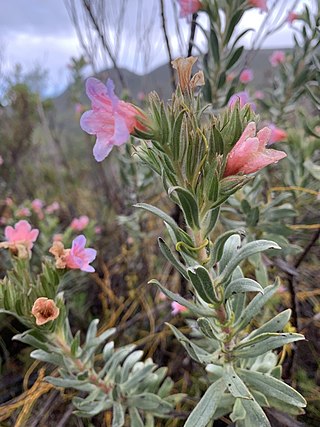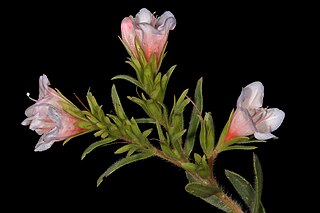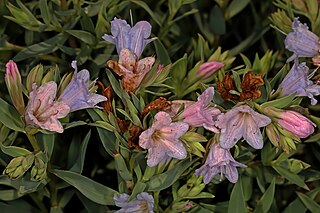
Wahlenbergia capensis, commonly known as the Cape bluebell, is a plant in the family Campanulaceae and is native to the Cape Province but has been introduced to Australia. It is an annual herb with up to four greenish blue, bell-shaped flowers with spreading petal lobes.

Trichodiadema pygmaeum is succulent plant of the genus Trichodiadema, native to the Western Cape Province, South Africa, where it is found in fine-grained soils in the regions of Bredasdorp and Swellendam.

Lobostemon is a genus of flowering plants belonging to the family Boraginaceae. It is endemic to the Cape Provinces of South Africa. The majority of species are limited to the winter rainfall area of the country, from Springbok to Mossel Bay. In Afrikaans these species are known as agtdaegeneesbos, or loosely translated, bush that will heal in eight days. As this name suggests, many species have medicinal properties. This is best known from Lobostemon fruticosus, which is used for treating wounds, blood poisoning, ringworm, skin diseases and syphilis.

Lobostemon montanus, the turquoise bush bugloss, mountain lobostemon or agtdaegeneesbos, is a South African species belonging to the forget-me-not family.

Lobostemon argenteus, or the silver healthbush, blue rocket bugloss or disselblaarluibos, is a species in the forget-me-not family that is endemic to South Africa.

Lobostemon belliformis, the Gouriqua lobostemon or beaut healthbush, is a critically endangered species in the forget-me-not family. It is known from a single locality on the Riversdale Plain in South Africa.

Lobostemon capitatus is a species belonging to the forget-me-not family. It is endemic to the Western Cape of South Africa, where it is found between Porterville and Bredasdorp.

Lobostemon curvifolius, the largeflower healthbush, is a species of the forget-me-not family from South Africa.
Lobostemon collinus, the pyjamabush or iron healthbush, is a species belonging to the forget me not family. It is known only from the fynbos biome of the Western Cape of South Africa.
Lobostemon cinereus, the ash healthbush, is a species belonging to the forget-me-not family. It is endemic to the Cape Provinces of South Africa.
Lobostemon decorus, the Rooiberg healthbush, is a species belonging to the forget-me-not family. It is endemic to the Western Cape of South Africa.
Lobostemon echioides, the common healthbush, is the mostly widely distributed species in its genus. It is endemic to the Cape Provinces of South Africa, where it is found growing between Namaqualand and the Karoo and the Eastern Cape.

Lobostemon fruticosus, also known as the eightday healthbush or pyjamabush, is a species of medicinal plant endemic to the Cape Provinces of South Africa. It is considered to be ecologically and economically important but is declining due to overexploitation.
Lobostemon glaber, the renoster healthbush, is a species of plant from South Africa. It is in the forget-me not family.

Lobostemon glaucophyllus, the smooth-leaved bush bugloss or grey healthbush, is a South African plant species belonging to the forget-me-not family. It is endemic to South Africa's Cape Provinces.
Printzia pyrifolia is a species of plant from South Africa.
Cheiridopsis purpurea is a species of succulent plant from South Africa. It is found growing in the succulent Karoo vegetation type.
Helichrysum sphaeroideum is a species of flowering plant in family Asteraceae. It is native to the Cape Provinces of South Africa.
Schistostephium griseum is a species of plant from southern Africa.
Nemesia glaucescens is a species of plant endemic to South Africa. It belongs to the figwort family.









